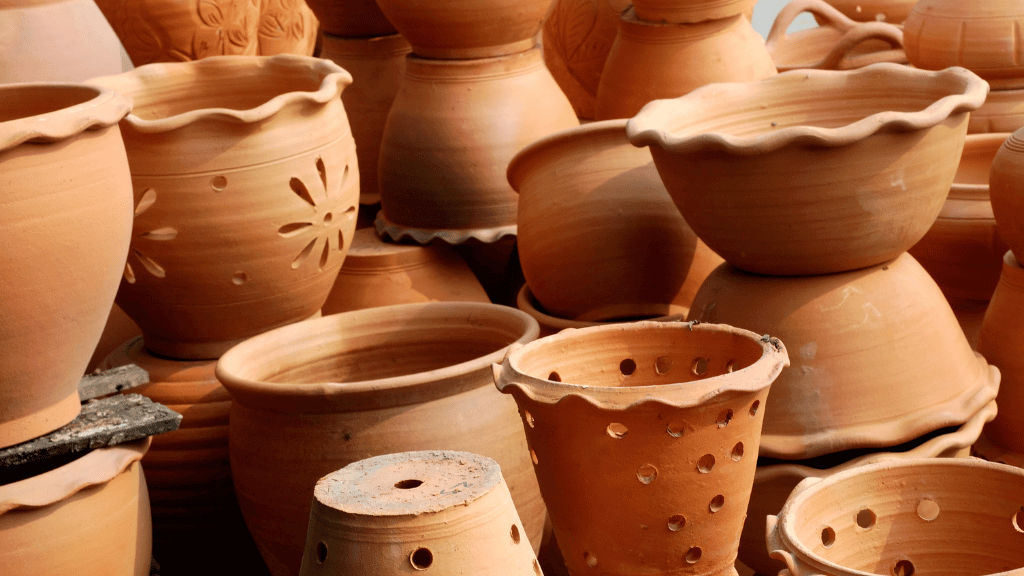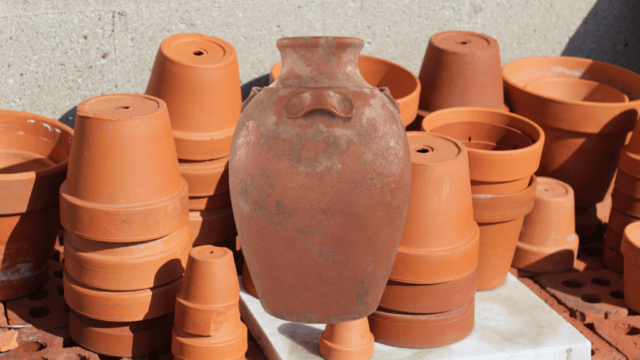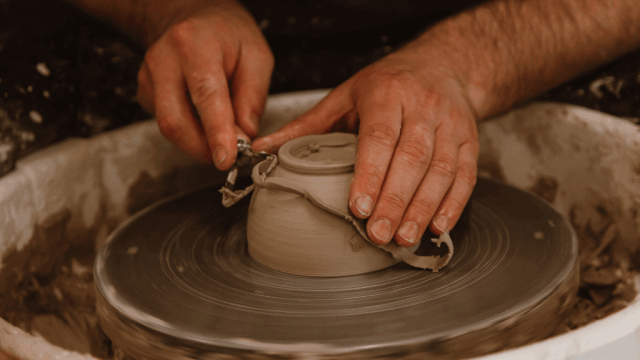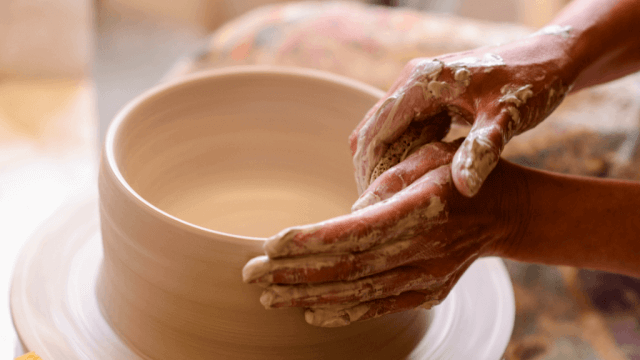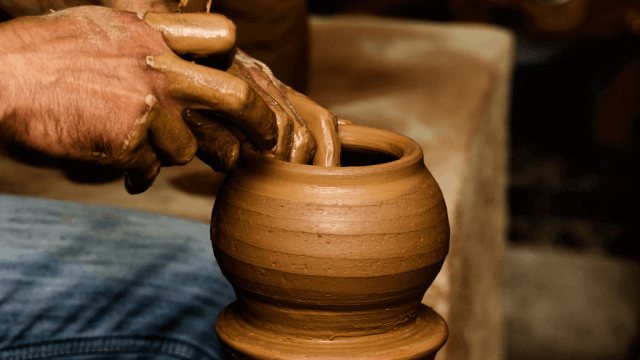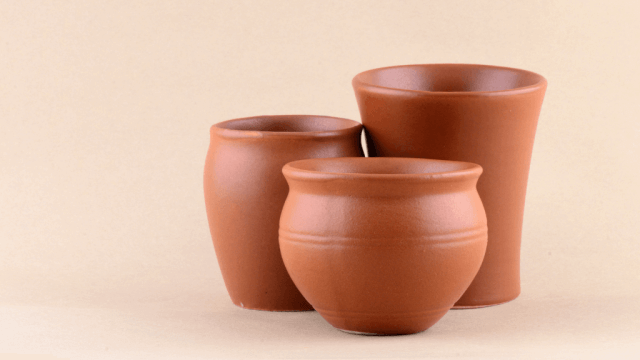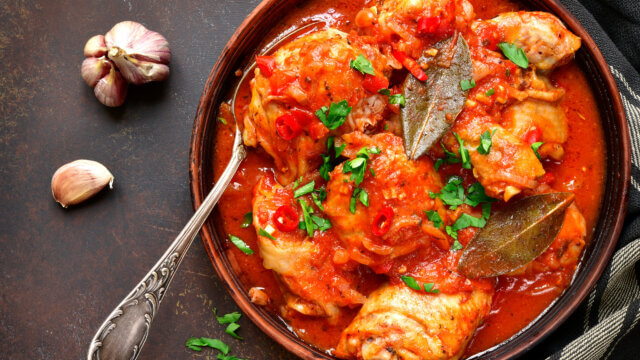Earthenware pottery refers to ceramic objects made from clay, fired at relatively low temperatures (typically below 1200°C) and often left unglazed or featuring a simple glaze.
Earthenware is porous, making it suitable for decorative, utilitarian, and oven-safe baking purposes.
In addition, it’s versatile and available in many forms, colors, and designs.
Some common earthenware types include terracotta, redware, and creamware.
What Is Earthenware Pottery?
Earthenware pottery is a type of ceramic made by molding clay and firing it at relatively low temperatures, typically below 1200°C (2192°F).
It is characterized by its porous nature, versatility, and decorative appeal.
Earthenware is available in many forms, colors, and designs, making it an attractive choice for both utilitarian and artistic purposes.
In this blog post, we will explore the key aspects of earthenware pottery, its types, and its uses.
Types of Earthenware Pottery
There are several types of earthenware pottery, each with distinct features and applications.
The main types include:
Terracotta
Terracotta, which means “baked earth” in Italian, is a type of earthenware made from red to brown clay.
It is typically unglazed but can be finished with slips or engobes to create a smoother surface.
Terracotta is often used for garden pots, sculptures, roof tiles, and decorative elements due to its durability and aesthetic appeal.
Redware
Redware is another type of earthenware, characterized by its reddish or dark brown color resulting from iron-rich clay.
It can be glazed or unglazed and commonly features surface decorations and patterns.
Redware is frequently used for domestic tableware and kitchenware such as plates, cups, and bowls.
Creamware
Creamware is a type of earthenware made from white-firing clay and often glazed with a clear or tinted lead glaze.
As the name suggests, it has a delicate creamy color and is typically used for fine dinnerware and ornamental pieces.
Uses of Earthenware Pottery
Earthenware pottery serves various practical and decorative purposes, making it popular across different cultures and time periods.
Some common uses include:
Tableware
Since earthenware retains heat well, it is ideal for serving food, especially hot dishes.
Plates, bowls, cups, and teapots made from earthenware are common, providing functionality and aesthetic appeal to dining experiences.
Oven-Safe Baking Dishes
Many earthenware pieces can withstand oven temperatures, making them suitable for baking and roasting.
Popular examples include casserole dishes, pie plates, and tagines.
When using earthenware for baking, it is essential to avoid sudden temperature changes as it can cause the pottery to crack or break.
Gardening and Outdoor Decor
Because of its durability, earthenware is often used for outdoor applications.
Garden pots, planters, and sculptures made from terracotta and other forms of earthenware are both functional and visually appealing, adding character to gardens and outdoor spaces.
Artistic Pieces
Earthenware’s versatility in form and design makes it an excellent medium for artistic expression.
Ceramic artists and hobbyists alike can create sculptures, wall art, and decorative pieces to celebrate the unique characteristics of earthenware pottery.
Caring for Earthenware Pottery
Maintaining the appearance and functionality of your earthenware pottery is essential for prolonging its lifespan.
Here are some practical tips for caring for your earthenware pieces:
Cleaning
Handwashing is recommended for earthenware as dishwashers can cause damage or deterioration.
Use warm water, mild dish soap, and a soft sponge or cloth to clean the pottery.
Avoid abrasive cleaners or scrubbing tools that can scratch the surface.
Storage
When storing earthenware, provide ample space between items to prevent chipping or cracking.
It is also essential to keep unglazed earthenware in a dry place to avoid damage from moisture absorption.
Temperature Changes
Because earthenware can be sensitive to sudden temperature changes, it is crucial to introduce gradual changes in temperature when using it for cooking or baking.
For instance, avoid placing a cold earthenware dish directly into a hot oven or putting a hot dish on a cold surface.
History of Earthenware Pottery
Earthenware pottery has a long history dating back thousands of years to some of the earliest human civilizations.
Due to the widespread availability of clay as a raw material, the craft of earthenware pottery has been practiced across continents and cultures, resulting in a rich heritage of diverse techniques and styles.
Ancient Civilizations
Earthenware pottery has been discovered in sites belonging to ancient civilizations, such as the Egyptians, Mesopotamians, and Chinese.
These artifacts reveal the important roles earthenware played in daily life and religious customs, as well as the sophisticated techniques used by artisans at the time.
Medieval Europe and Islamic Golden Age
During the Middle Ages, European potters created earthenware for both functional and decorative purposes.
Islamic potters from the Middle East and North Africa also created intricate earthenware with unique glazes and surface decorations that influenced European earthenware styles.
Renaissance to Modern Day
Throughout the Renaissance and the hundreds of years following, earthenware pottery continued to evolve.
Today, it remains popular as both a functional and artistic medium, with countless artists and hobbyists producing innovative and creative designs that reflect the diversity of this time-honored craft.
FAQ: Earthenware Pottery
In this FAQ section, we answer some common questions related to earthenware pottery, its use, and care.
Feel free to refer to this section for quick answers to your queries about this beautiful and functional pottery type.
What is the difference between earthenware, stoneware, and porcelain?
Earthenware is a porous ceramic fired at lower temperatures, while stoneware is more durable, less porous, and fired at higher temperatures (around 1200-1300°C).
Porcelain is a ceramic material made from kaolin clay fired at very high temperatures (up to 1400°C), resulting in a dense, translucent, and nonporous material.
Can I use earthenware pottery in the microwave?
Glazed earthenware is generally microwave-safe, though unglazed terracotta dishes may not be suitable for microwave use.
It is essential to check the manufacturer’s instructions to ensure that your specific earthenware piece is safe for microwave use.
Is earthenware dishwasher safe?
Although some glazed earthenware may be dishwasher safe, handwashing is recommended to preserve the finish and prevent chipping or cracking.
Use warm water, mild dish soap, and a soft sponge or cloth when handwashing earthenware.
Can earthenware pottery be used on stovetops?
Most earthenware is not suitable for direct use on stovetops or open flames, as the pottery may crack due to the high temperatures and direct heat.
Use oven-safe earthenware dishes for baking and always follow the manufacturer’s instructions for temperature limitations and usage guidelines.
How can I repair a broken or chipped earthenware piece?
For minor chips or cracks, you can use a food-safe epoxy or ceramic adhesive to repair the earthenware piece.
For larger breaks, professional restoration services are recommended.
However, note that a repaired earthenware piece may not be suitable for food use or exposure to high temperatures.
